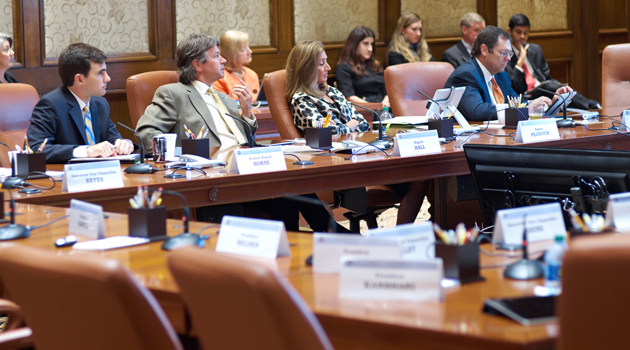Regents to Consider Funding for UT’s Engineering Research Center
At a board meeting tomorrow, UT System regents will consider a plan to help fund UT-Austin’s proposed engineering hub, the Engineering Education and Research Center, after months of legislative gridlock. If approved, the System could allow bonds to fund up to $150 million of the project’s $310 million price tag, in addition to the $105 million the board has already agreed to contribute to the project.
The new funding model is meant to make up for the shortfall left after the Texas Legislature failed to pass tuition revenue bonds (TRBs) during this year’s legislative session. The bonds, which were targeted at construction projects at public colleges across the state, are generally offset by general revenue appropriations, lessening a school’s need to pay back the debt. Though TRBs saw broad support in both chambers, the House and Senate ran out the clock on the regular session before a final agreement could be reached. Gov. Perry failed to include the bonds in the call for any of the three tumultuous special sessions.
The new facility will replace the cramped, outdated buildings currently serving the Cockrell School of Engineering. The original plan called for about a third of the funding to come from the UT System’s Permanent University Fund, a third from the legislature, and a third from philanthropy, with $5 million coming from UT-Austin’s own coffers.
Despite some large endowments, public universities in Texas lack their own standing budgets for capital campaigns, which is why new construction at UT and all over Texas often comes from fundraising. This year, with TRBs left at the capitol steps and fundraising totaling $35 million—with an additional $30 million in oral commitments—a regental vote to approve new sources of funding may be the next step in making the flexible, forward-thinking engineering center a reality.
Under the new plan, UT may need to shoulder some debt if fundraising goals aren’t met. UT-Austin officials are confident that won’t happen. The System could approve $95 million in what is called revenue financing system bonds. UT would essentially borrow the amount of the failed TRB and possibly an additional $55 million to offset yet-to-be-raised donations. The University would have until 2017 to pay back the loan.
The current and proposed funding schemes, taken from the regents’ agenda book, is shown below.
“The additional [funding] is meant to make up for the shortfall due to no TRB availability. UT will still be required to meet their fundraising goal, but would get more time to do so,” says Jenny LaCoste-Caputo, a UT System spokeswoman.
Because the new injection of $150 million—a 63 percent increase in System money over previous plans—is designed to match fundraising, the University may need to repay the System up to $55 million if fundraising totals aren’t met by 2017, according to the Austin American-Statesman. UT-Austin officials don’t think that will happen and say the total gifts raised for the project so far are strong.
“We believe that’s the most ever raised for a single building project in UT-Austin history,” UT spokesman Gary Susswein told the Statesman. “So we’re already ahead of where we’ve ever been for any other building.”
The board’s agenda for Thursday’s meeting also includes “investment metrics,” or measurements that regents may use to rate the effectiveness of investing in the EERC, a facility that regents’ documents call “critical.” This list, meant to be reviewed by 2019-20 includes:
- Increase of 1,000 undergraduate engineering students above the current baseline of the immediate past academic year. New teaching labs will allow innovations in curriculum, improve ability to attract top undergraduate students, and improve graduation rates.
- Increase in interdisciplinary research space, with an estimated annual increase of $14 million in research expenditures
- Increase the number of faculty and from 65 faculty to 74 faculty and from 300 PhD students to 480.
- Double the current level of $18.3 million of annual research expediture in the Electrical and Computer Engineering (ECE) Department.



















No comments
Be the first one to leave a comment.